The Colors of Mars part 2
The Mars Exploration Rovers
The MER rovers have returned many hundreds
of color images, 'natural' as well as infra red enhanced. Besides
the archive
of press release images compiled during the course of the
mission, The MER imaging team has released a dedicated source
of high fidelity Pancam
true color images. Jim Bell, the guiding hand behind the site,
and his team have excelled in conveying what the cameras are showing
us. This site
by Damien Bouic (in French) is an excellent collection of
panoramas and color products, one of several such excellent sites.
The use of calibrated data as it is released to the PDS
Imaging Node entails downloading the files desired and using
software like NASAView
or GIMP, among others, to convert
them to formats useable in image editing programs.
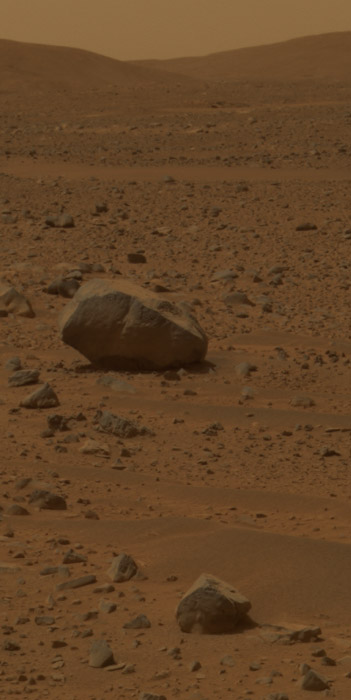
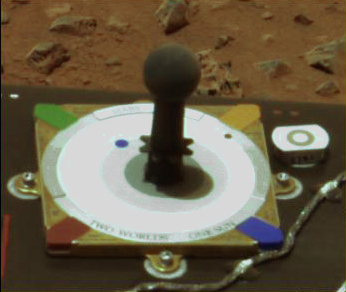 At left is a color
image showing the 'Spirit' rover color sundial/test chart against
the Martian surface. The upper right color chip is a dull yellow
ochre. The white parts of the color chart base are overexposed
here. The darkness of Martian soil is evident.
At left is a color
image showing the 'Spirit' rover color sundial/test chart against
the Martian surface. The upper right color chip is a dull yellow
ochre. The white parts of the color chart base are overexposed
here. The darkness of Martian soil is evident.
At right we see a similar scene, color balanced
to match the ground seen behind the sundial. The sky, thus reasonably
matched to the color chart, is shown to be strongly tinted with
suspended dust which, due to lack of shadowing, appears as a luminous
version of the color of the dust draped over the larger rocks.
These MER images (aside from the sundial images
above and below, which I color balanced to better resemble the
actual color chips) are from the Pancam
true color images site, although I have 'fine tuned' them
in relation to others in hue, brightness and saturation to attempt
matches between the background surface seen with the color chips
and wider views made under similar conditions which include the
sky. The original image files are works of beauty and undoubtedly
the best such color products to use for serious color investigations.
Some differences in camera exposure, saturation, and minor color
balance issues complicate zeroing in on where to 'anchor' ones
color impression. Images containing the ground next to items of
known color such as the color charts are the best place to start.
Below: Two photos of the MER sundial target
shows the central 'mast' before and after it was painted black
to reduce reflections. Otherwise they are identical, with the
color chips color balanced to resemble the original, in particular
the 'yellow ochre' chip, with verbal descriptions augmenting the
available phorographs.
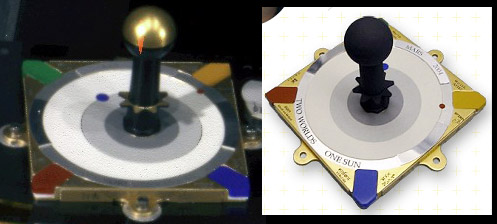
Below is a panorama of the 3 km distant 'Columbia
Hills', named after the crew which perished in the last mission
of that shuttle orbiter.


As the 'Spirit' rover wandered among
the hills, this view was obtained looking up enough to show the
sky there appearing darker than the nearby sunlit hilltops.
'Opportunity' at Meridiani.

Left: an attempt to color balance the sundial
chips on the second rover 'Opportunity'.
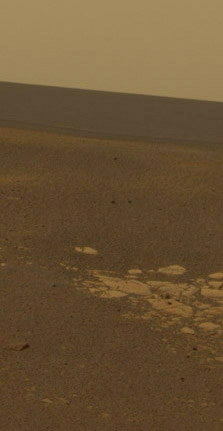
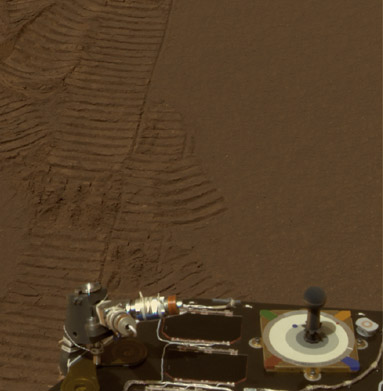
Left: surroundings with roughly similar color
balance as the view to the right, including the sky.
Right: 'down Sun' unshadowed colors of the
fine 'soil' of Meridianii with the color chart providing a reasonable
color balance.
And for a near natural size closeup of the
'blueberry' laden dust of Meridianii with some hardward in the
foreground.

Phoenix
The Phoenix lander has yet to fully tell its
tale of the colors around it. Below left is an attempt at a careful
color balancing of an early released color image, showing the
progress of the adhering of the iron rich fine dust to the outer
ring of magnets which tend to protect the inner portions from
being discolored.
The colors of Mars-page
3
The
colors of the Solar System


 At left is a color
image showing the 'Spirit' rover color sundial/test chart against
the Martian surface. The upper right color chip is a dull yellow
ochre. The white parts of the color chart base are overexposed
here. The darkness of Martian soil is evident.
At left is a color
image showing the 'Spirit' rover color sundial/test chart against
the Martian surface. The upper right color chip is a dull yellow
ochre. The white parts of the color chart base are overexposed
here. The darkness of Martian soil is evident.





